|
|
|
| |
|
|
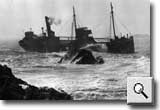 |
| Shipwrecks |
| |
The Middlesborough
coaster Brightside ran aground on rocks off Hackley
Head near Collieston on 24th April 1949 in thick fog.
The crew of nine got clear in a small boat and were
picked up by the Kirkcaldy drifter Noontide three
hours later and were put ashore at Aberdeen.
Before abandoning ship the Brightside’s master,
Captain J.W.Hopper of Sunderland, sounded the siren
for assistance. It jammed and brought Collieston Coastguards
and the Life Saving Brigade hastening to the cliff
top.
Unable to see the coaster because of the thick fog,
they aimed rope-carrying rockets in the direction
from which the noise of the siren was coming. For
a few minutes the fog lifted and they saw one line
had fallen across the ship. They then realised that
the crew had managed to get away. |
|
|
| |
|
|
| |
The breeches
buoy is clearly visible as are two members of the
rescue party, happy that on this occasion no lives
were lost. To the right leaning on the pole is Jack
Ingram who was on holiday at the time staying with
his parents at No 2 Cluny Cottages. Jack’s father,
Charles Ingram, was a long serving member of the Collieston
Coast Guard Company.
|
|
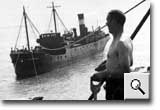 |
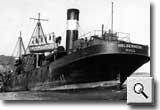 |
The
S.S. Holdernook ran aground on dangerous rocks a quarter
of a mile north of Hackley Head near Collieston on
21st August, 1947. The Collieston Coastguard Company
was alerted and immediately proceeded to the scene
intending to assist in the rescue of the crew.
Having set up their rescue gear they had to keep it
in hand owing to the working of the vessel in the
heavy seas. The ship’s crew were hesitant to
use the breeches buoy due to the stormy conditions
and were subsequently rescued by the Newburgh Lifeboat
and landed safely at Collieston.
|
| |
|
|
| |
| |
|
|
| |
World War
2 |
|
| |
| |
A
form written in English and Norwegian, signed by a
Norwegian Brigadier and dated 29th December 1941.
The pass was issued to Lewis Mackie, a coast watcher
and temporary coastguard, to identify him to any Norwegian
Forces which he might meet while on patrol from Collieston
to the mouth of the River Ythan, part of the area
also covered by the Norwegian Brigade during the 1939-1945
World War.
Once while on patrol Lewis discovered a partly hidden
dinghy which had been brought up from the shore by
some Germans landing from a submarine. The Germans
were eventually caught further north in Moray. |
|
 |
| |
|
|
| |
|
|
 |
Jack
Walker, whose father Thomas saw active service in
the Dardanelles during the First World War, was a
child of thirteen when the Second World War broke
out. Like so many of his contemporaries, Jack kept
a scrapbook which he began compiling after the death
of King George V in 1937.
Among the many newspaper cuttings adorning the pages
of the wartime years of the scrapbook are some of
Jack’s own cartoon drawings of his heroes and
villains. Judging by Jack’s depiction of Hitler,
he clearly fell into the latter category.
Jack, a cadet in the Merchant Navy, went on to study
at the School of Navigation in Aberdeen and by the
end of the war in 1942 Jack, then a young man, had
seen action in the Mediterranean during the Italian
Campaign.
|
| |
|
|
| |
|
|
| |
| Rescue
at Sea |
| |
Dick Ingram
is wearing the Bronze Medal for Gallantry in Saving
Life at Sea awarded to him by King George V1. The
Hull steamer Lesrix ran aground on the rocks off Hackley
Head during a storm on January 26th 1942.
Dick and George Ross, a young lad from the village,
rescued four men by breeches buoy from the bow of
the steamer but the unrelenting blizzard conditions
caused the stern of the Lesrix to break away and sink
with the loss of ten of her crew.
Dick’s heroism was recognised when he was awarded
the Gallantry medal for life saving at sea, while
the unfortunate young George received nothing more
than a rebuke from the headmaster for not turning
up for school that day. |
| |
|
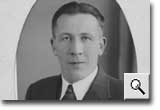 |
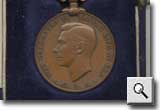 |
The
Bronze Medal for Gallantry in Saving Life at Sea was
awarded to Richard (Dick) Ingram for his part in the
rescue of members of the crew of the Hull steamer
‘Lesrix’ which ran aground on the rocks
off Hackley Head during a storm on January 26th 1942.
The obverse of the medal gives the effigy of King
George V1 and the Royal Cypher with the words ‘For
Gallantry in Saving Life at Sea.’ The ribbon
is scarlet with two narrow white vertical stripes.
Accompanied by his sister, Isabella, Dick travelled
to London where the medal was presented to him by
King George V1 at Buckingham Palace on 13th October,
1942.
|
| |
|
|
| |
|
|
| |
Education |
|
| |
| |
Pupils
and Head Teacher of Collieston School in 1949. The
school originally opened in 1877 but had to close
temporarily in 1922 due to falling numbers in the
school roll. The remaining children from the village
were then required to travel some three miles to the
nearest school at Slains to continue with their education.
However, due to subsequent overcrowding at Slains
School, the school in Collieston was re-opened in
1932. Sadly its reprieve was not to be permanent
and
it eventually closed for the last time on July 1,
1949.
The school building is now the Collieston Community
Centre and many local organisations such as the Children’s
Playgroup, Over 60’s Club and Women’s
Rural Institute, meet in the Centre on a regular basis.
|
| |
|
 |
|
 |
|
| ....copyright
collieston's century 2003 |
|